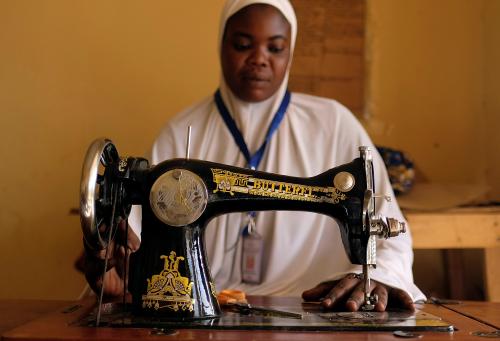Below is a viewpoint from Chapter 4 of the Foresight Africa 2018 report, which explores six overarching themes that provide opportunities for Africa to overcome its obstacles and spur inclusive growth. Read the full chapter on African structural transformation here.
The adoption of labor-saving technologies associated with Industry 4.0—the Internet of Things, advanced robotics, and 3-D printing—in high-income economies is reducing the importance of low wages in determining costs of production. China, too, is automating at a rapid rate and is projected to be the largest user of industrial robots by 2018. This trend potentially narrows the path for less-developed countries in Africa to industrialize—the expected en masse migration of labor-intensive manufacturing activities to poorer economies with lower labor costs, such as those in Africa, may not occur.
But manufacturing is not monolithic in terms of the extent of automation. The adoption of robots, for example, varies considerably across sub-sectors (Figure 4.2). Some manufacturing industries are relatively unaffected and will therefore remain feasible entry points for less-industrialized countries. This includes a range of commodity-based manufactures such as basic metals, non-metallic mineral products, wood products, paper products, and food processing, which are also less traded and therefore subject to less international competition.

Despite being highly traded internationally, there will also be opportunities for African countries to be competitive in the production of labor-intensive tradables such as textiles, apparel, and leather products, which is the least automated subsector—thus far.
Given current automation trends, there will likely be fewer entry points in global value chains for African countries, and industrialization could become increasingly challenging.
Further, there will likely still be room for lower-quality, lower-price goods produced and consumed domestically. This possibility follows from the experience of large developing countries like China and India where highly traded manufacturing sectors have been characterized by segmented markets. The scope for productivity gains might be greater for those lower-quality, lower-price goods that are regionally traded, where countries can exploit opportunities beyond the domestic market. This opportunity holds considerable promise in Africa where almost all manufacturing industries have seen large increases in their intra-Africa trade shares over the last decade and a half (Figure 4.3). Given current automation trends, there will likely be fewer entry points in global value chains for African countries, and industrialization could become increasingly challenging. While there may be opportunities to “leapfrog” to new technologies, developing the relevant worker skills, firm capabilities, and infrastructure is likely to be a more gradual process. Yet, there is still scope for countries using Industry 2.0 technologies to compete if other ecosystem requirements are met. If countries in Africa can integrate their growing labor force with substantial improvements in their business environments, logistics and other backbone services, regulatory requirements, and so on, this approach might slow down the adoption of Industry 4.0 technologies in the higher-income countries.









Commentary
Foresight Africa viewpoint – Is automation undermining Africa’s industrialization prospects?
January 22, 2018